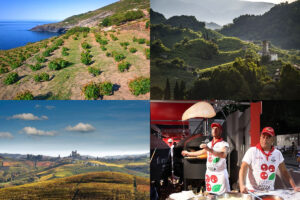What will 2010 be like for the wine world? The first forecast of the year comes from the American John Mariani, wine signature for the Bloomberg group. Here’s the translation of the article published on the site www.bloomberg.com.
It had been since the madness of the end of the millennium in 1999 that I had not seen so much frenzy on the wine market. In 1999 there was the boom of stock orders, auction houses were breaking record on record, Champagne producers were warning there would not be enough to toast the holidays. The producers were thrilled and prices of bottles were decided month to month. What a difference a decade can make. With high unemployment rate, spending budgets down and an excess of wine, it is the consumer’s turn to be happy with lower prices, more choice and fewer pretenses. A ranking of 99 points is no longer a requirement to buy good wine.
So, what will happen in 2010...
1 – Prices will keep falling on the prestigious Bordeaux and Burgundy wines as well as the California cult wines, which at one time were available only on order. The same goes for Italian, Spanish and Chilean producers who thought they could get the same prices as the oldest wineries in France.
2 – More and more people will buy on line. Consumers can visit sites like wine-searcher.com or vinfolio.com and compare prices for the same wine not only in the U.S. (where most States now allow shipments State to State) but also the U.K., Germany and other countries. The difference can be surprising: a bottle of wine might cost 40 dollars in one store and 75 dollars in another. And the wine tasting stores will stock the more economical wines, to ensure a bigger profit.
3 – Wine blogs will become more and more popular, especially among users who make claims of having found incredible bottles of wine at under 15 dollars. However, as for all blogs, the user will have to check out the source of such claims.
4 – Unfortunately, California won’t be able to turn back from the high alcohol content of their woody whites and reds because the producers themselves believe the majority of American consumers want this kind of elegant and complex wine. The problem is that the same types of the less expensive wines are terrible, have no balance and are undrinkable, after the first glass. The California Wineries have played well on finesse, but then they have let their grapes ripen too much and have used new wood for too long a time.
5 – The tsunami of new wines from South America and Eastern Europe will decline due to surplus on the market. The Greek, Portuguese and Brazilian wines have had a good response from the press in recent years, but unless they keep prices low, they will not go a long way.
6 – The New Zealand Wineries will be in trouble. The most recent prodigious harvests have saturated the market with their super fruity wines, and many fans now want a quality leap.
7 – Champagne will have serious trouble. Not just because the prices have climbed too high (too many bottles are sold for over 100 dollars) but also because other producers of bubbly wines have been very good at getting their wines in high rankings, well-reviewed and keeping prices interesting. In Champagne, the producers are cutting down production and keeping the already bottled wine to balance the situation, but it will be a tough fight against the new success of Prosecco from Italy, the bubbly wines of California and the Cava from Spain. There are too many labels of Champagne on the market.
8 – High-end restaurants will buy small quantities of expensive wines after cutting budgets, waiting to place previously purchased wines with large investments. They’ll wait until the client says to the sommelier: “the price does not matter”. Good luck on that. Fewer “top” restaurants will still be open. New humbler places will open offering wine menus with small and interesting wine labels from around the world, and will sell them at reasonable prices.
9 - Many producers would switch from cork to screw caps to avoid problems with bottled wine due to stoppers and oxidation, and also to make wine more accessible to the average consumer. The uncomfortable truth is that many winemakers I spoke to said they would like to switch to screw cap, but they think that consumers would think the wine less valuable - very stupid.
10 – Americans will buy wine under 10 dollars a bottle. The best bet for a growing market is China, which is thirsty for good, cheap wines. And, like with everything else, soon the Chinese will be producing wine themselves.
Copyright © 2000/2025
Contatti: info@winenews.it
Seguici anche su Twitter: @WineNewsIt
Seguici anche su Facebook: @winenewsit
Questo articolo è tratto dall'archivio di WineNews - Tutti i diritti riservati - Copyright © 2000/2025








































































































































































































